2005 RENAULT MEGANE tyre pressure
[x] Cancel search: tyre pressurePage 101 of 250
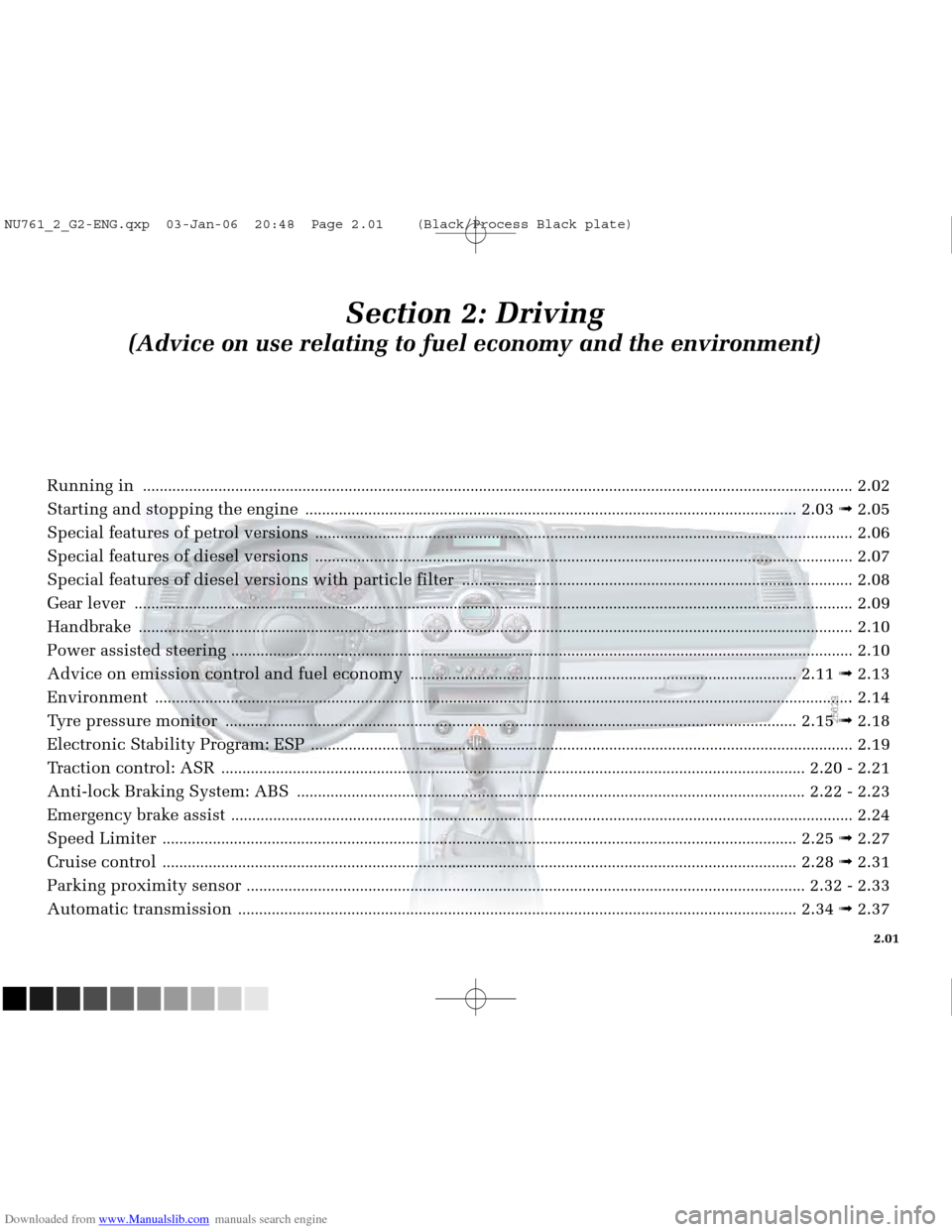
Downloaded from www.Manualslib.com manuals search engine
NU761_2_G2-FRA.qxd 4/11/05 10:48 Page 2.01
2.01
Section 2: Driving
(Advice on use relating to fuel economy and the environment)
Running in ........................................................................\
.................................................................................................2.02
Starting and stopping the engine
........................................................................\
.............................................2.03 ➟2.05
Special features of petrol versions
........................................................................\
....................................................... .2.06
Special features of diesel versions
........................................................................\
....................................................... .2.07
Special features of diesel versions with particle filter
........................................................................\
.....................2.08
Gear lever
........................................................................\
....................................................... ............................................2.09
Handbrake
........................................................................\
....................................................... ...........................................2.10
Power assisted steering
........................................................................\
....................................................... .....................2.10
Advice on emission control and fuel economy
........................................................................\
....................2.11 ➟2.13
Environment
........................................................................\
....................................................... ....................................... 2.14
Tyre pressure monitor
........................................................................\
....................................................... .........2.15 ➟2.18
Electronic Stability Program: ESP
........................................................................\
....................................................... ..2.19
Traction control: ASR
........................................................................\
....................................................... ............2.20 - 2.21
Anti-lock Braking System: ABS
........................................................................\
.................................................2.22 - 2.23
Emergency brake assist
........................................................................\
....................................................... .....................2.24
Speed Limiter
........................................................................\
....................................................... ........................2.25 ➟2.27
Cruise control
........................................................................\
....................................................... ........................2.28 ➟2.31
Parking proximity sensor
........................................................................\
....................................................... ......2.32 - 2.33
Automatic transmission
........................................................................\
....................................................... ......2.34 ➟2.37
NU761_2_G2-ENG.qxp 03-Jan-06 20:48 Page 2.01 (Black/Process Black\
plate)
Page 115 of 250
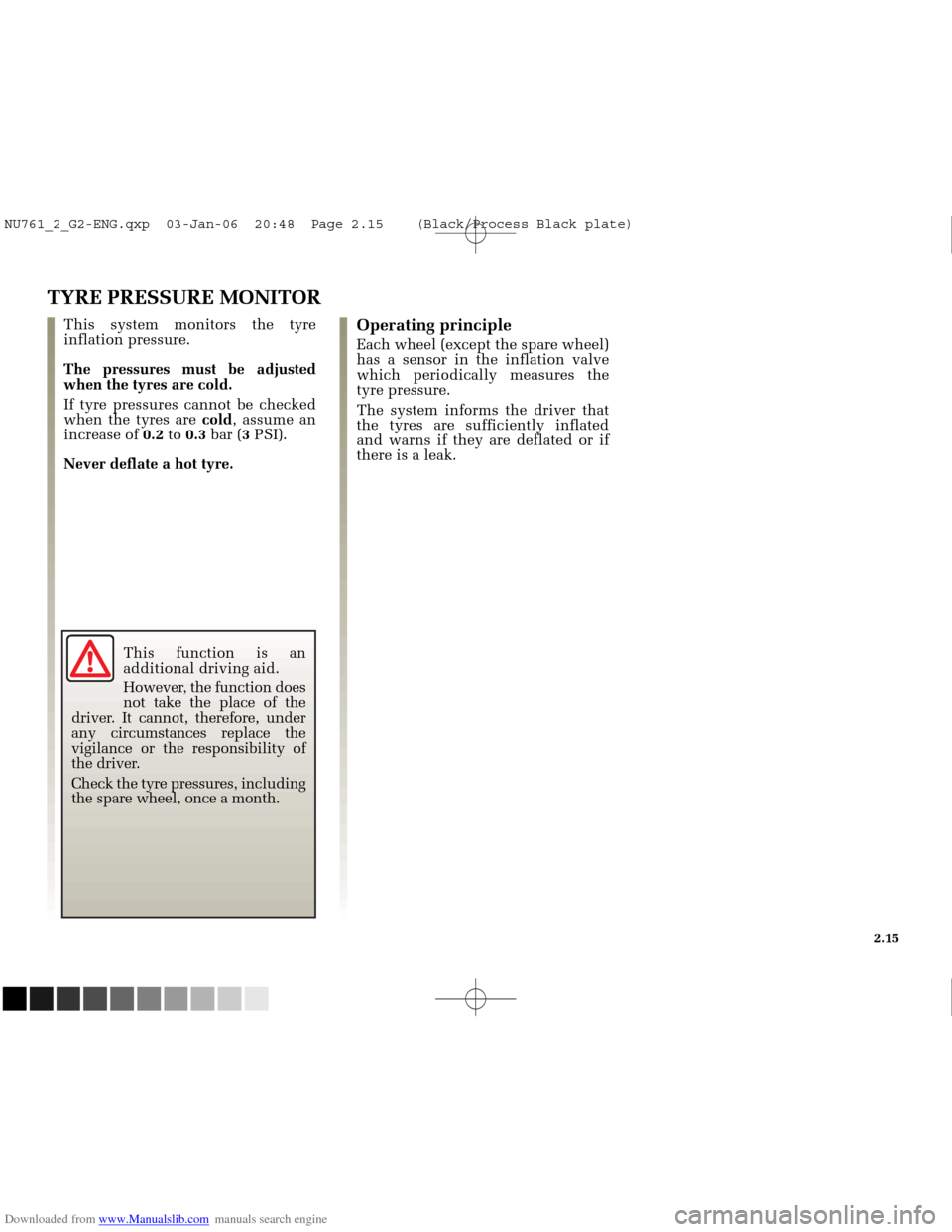
Downloaded from www.Manualslib.com manuals search engine
NU761_2_G2-FRA.qxd 4/11/05 10:48 Page 2.15
TYRE PRESSURE MONITOR
Operating principle
Each wheel (except the spare wheel)
has a sensor in the inflation valve
which periodically measures the
tyre pressure.
The system informs the driver that
the tyres are sufficiently inflated
and warns if they are deflated or if
there is a leak.
This system monitors the tyre
inflation pressure.
The pressures must be adjusted
when the tyres are cold.
If tyre pressures cannot be checked
when the tyres are
cold, assume an
increase of 0.2 to 0.3 bar ( 3PSI).
Never deflate a hot tyre.
2.15
This function is an
additional driving aid.
However, the function does
not take the place of the
driver. It cannot, therefore, under
any circumstances replace the
vigilance or the responsibility of
the driver.
Check the tyre pressures, including
the spare wheel, once a month.
NU761_2_G2-ENG.qxp 03-Jan-06 20:48 Page 2.15 (Black/Process Black\
plate)
Page 116 of 250
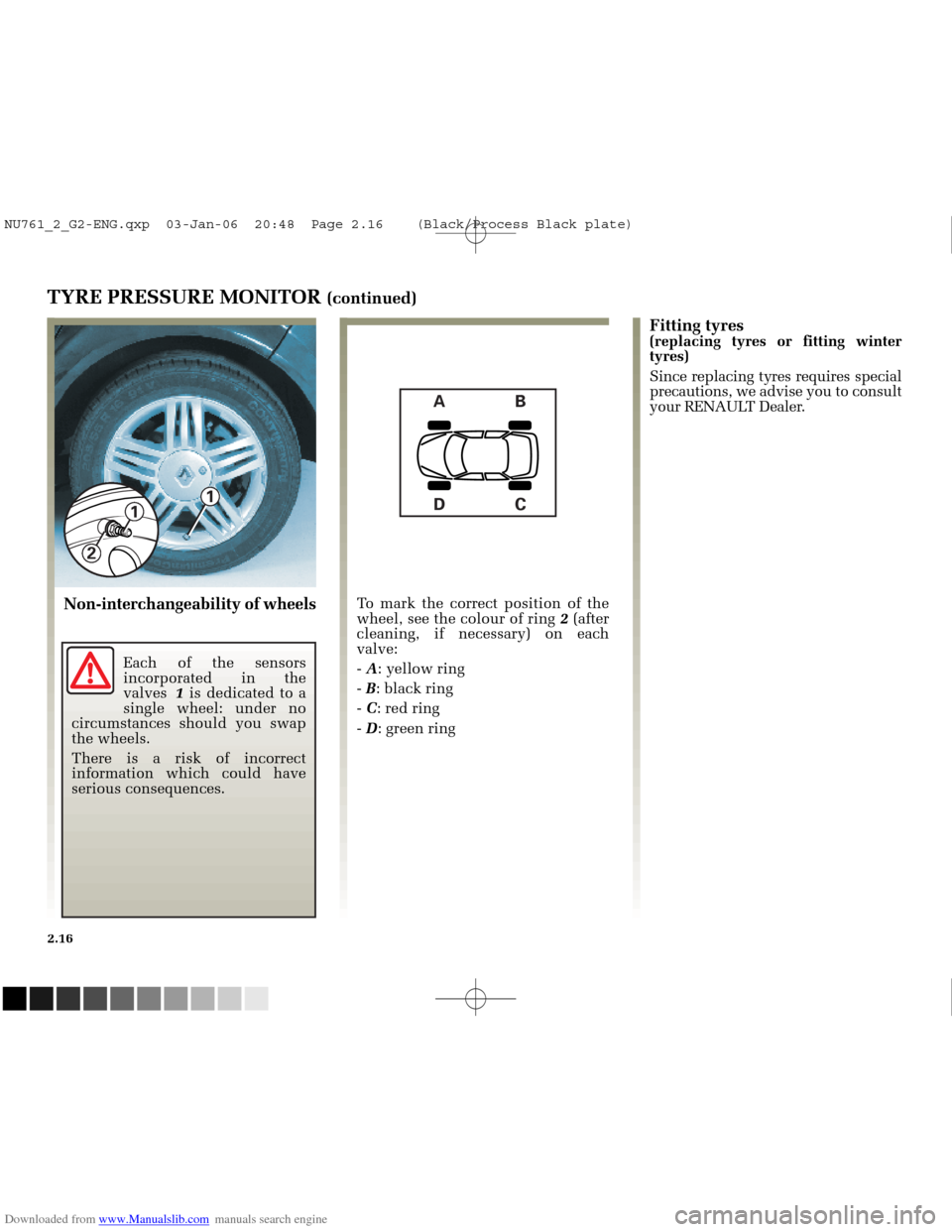
Downloaded from www.Manualslib.com manuals search engine
B
A
C
D
2
1
1
NU761_2_G2-FRA.qxd 4/11/05 10:48 Page 2.16
2.16
TYRE PRESSURE MONITOR (continued)
Non-interchangeability of wheels
To mark the correct position of the
wheel, see the colour of ring 2(after
cleaning, if necessary) on each
valve:
- A : yellow ring
- B : black ring
- C : red ring
- D : green ring
Fitting tyres(replacing tyres or fitting winter
tyres)
Since replacing tyres requires special
precautions, we advise you to consult
your RENAULT Dealer.
Each of the sensors
incorporated in the
valves 1is dedicated to a
single wheel: under no
circumstances should you swap
the wheels.
There is a risk of incorrect
information which could have
serious consequences.
NU761_2_G2-ENG.qxp 03-Jan-06 20:48 Page 2.16 (Black/Process Black\
plate)
Page 117 of 250
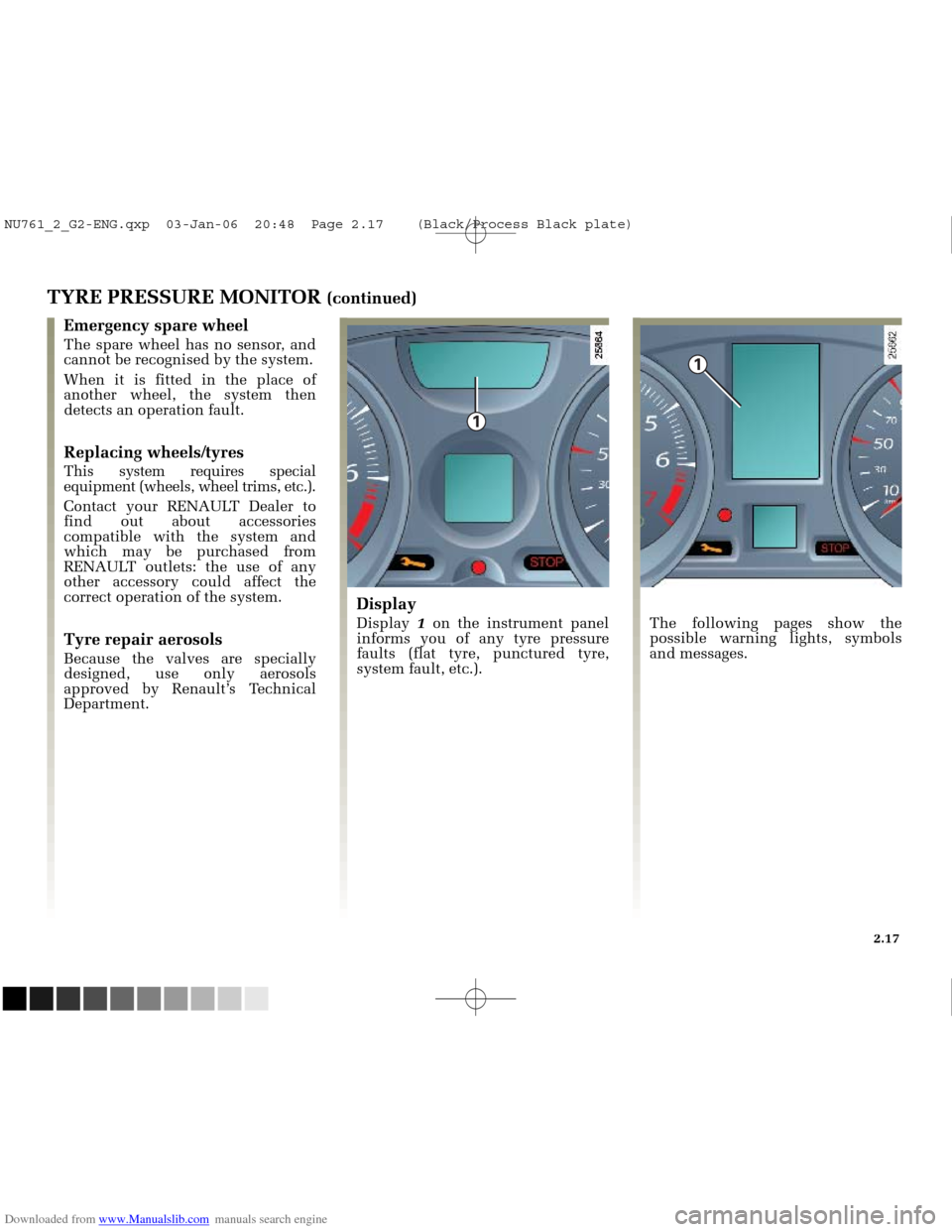
Downloaded from www.Manualslib.com manuals search engine
1
1
NU761_2_G2-FRA.qxd 4/11/05 10:48 Page 2.17
TYRE PRESSURE MONITOR (continued)
Emergency spare wheel
The spare wheel has no sensor, and
cannot be recognised by the system.
When it is fitted in the place of
another wheel, the system then
detects an operation fault.
Replacing wheels/tyres
This system requires special
equipment (wheels, wheel trims, etc.).
Contact your RENAULT Dealer to
find out about accessories
compatible with the system and
which may be purchased from
RENAULT outlets: the use of any
other accessory could affect the
correct operation of the system.
Tyre repair aerosols
Because the valves are specially
designed, use only aerosols
approved by Renault’s Technical
Department.
Display
Display 1on the instrument panel
informs you of any tyre pressure
faults (flat tyre, punctured tyre,
system fault, etc.). The following pages show the
possible warning lights, symbols
and messages.
2.17
NU761_2_G2-ENG.qxp 03-Jan-06 20:48 Page 2.17 (Black/Process Black\
plate)
Page 118 of 250

Downloaded from www.Manualslib.com manuals search engine
A
B
NU761_2_G2-FRA.qxd 4/11/05 10:48 Page 2.18
2.18
TYRE PRESSURE MONITOR (continued)Examples of messages which may appear on the display
"Check tyre pressure"
A shaded wheel B, indicates a
deflated tyre.
"Stop! Tyre puncture"
Replace the wheel affected Bor
contact a RENAULT Dealer.
This message appears along with the
ûwarning light.
"Inflate a tyre to motorway
pressure"
The tyre pressure is not suitable for
the speed of travel. Slow down or
inflate all fourtyres to motorway
pressure (refer to the tyre pressure
table).
"No tyre sensors" or "Tyre sensor
out of order"
One wheel A, disappears, indicating
that the sensor on this wheel is
missing or faulty (e.g. if the
emergency spare wheel is fitted
etc.).
NU761_2_G2-ENG.qxp 03-Jan-06 20:48 Page 2.18 (Black/Process Black\
plate)
Page 190 of 250
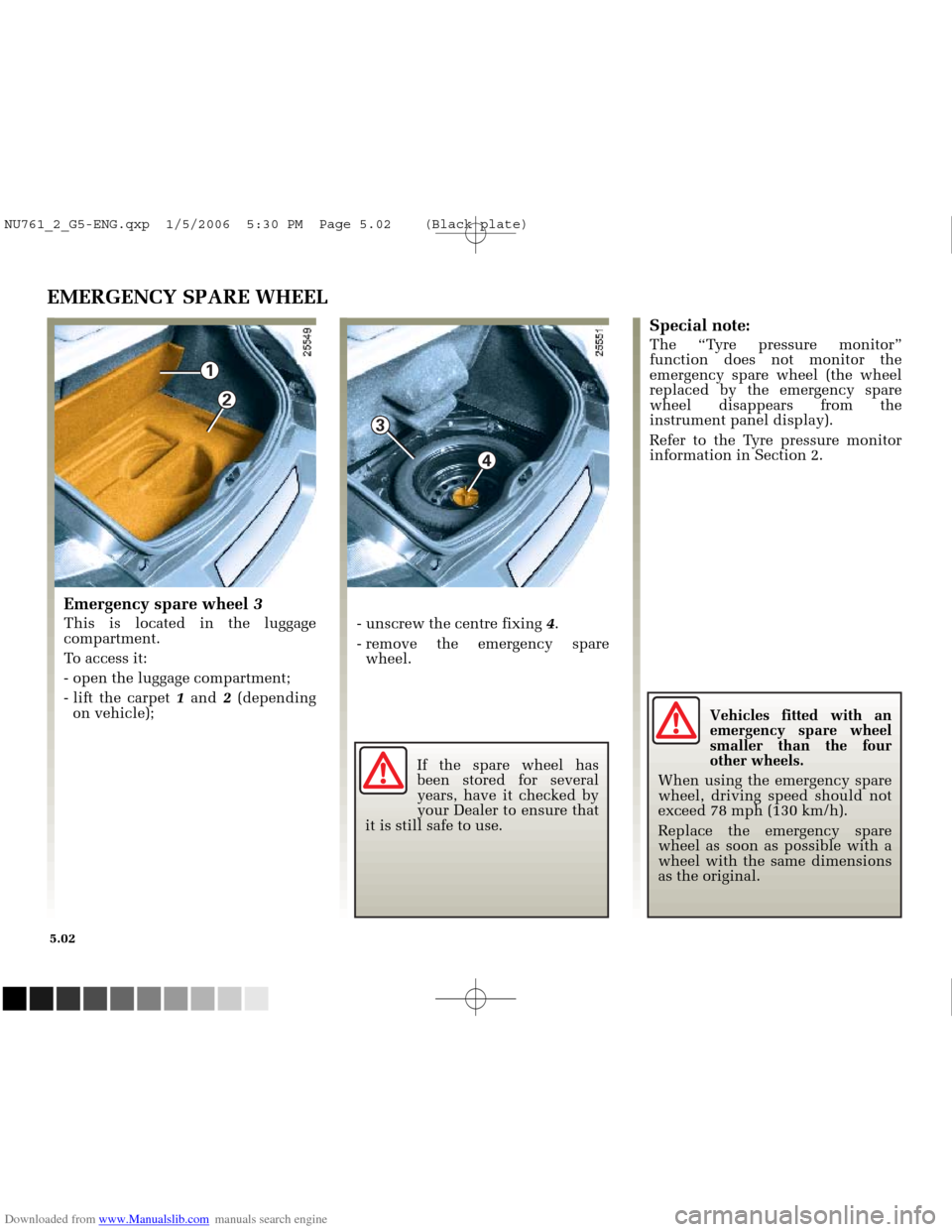
Downloaded from www.Manualslib.com manuals search engine
1
4
3
2
NU761_2_G5-FRA.qxd 4/11/05 11:09 Page 5.02
5.02
EMERGENCY SPARE WHEEL
Emergency spare wheel 3
This is located in the luggage
compartment.
To access it:
- open the luggage compartment;
- lift the carpet 1and 2(depending
on vehicle);
Special note:
The “Tyre pressure monitor”
function does not monitor the
emergency spare wheel (the wheel
replaced by the emergency spare
wheel disappears from the
instrument panel display).
Refer to the Tyre pressure monitor
information in Section 2.
- unscrew the centre fixing 4.
- remove the emergency spare wheel.
If the spare wheel has
been stored for several
years, have it checked by
your Dealer to ensure that
it is still safe to use. Vehicles fitted with an
emergency spare wheel
smaller than the four
other wheels.
When using the emergency spare
wheel, driving speed should not
exceed 78 mph (130 km/h).
Replace the emergency spare
wheel as soon as possible with a
wheel with the same dimensions
as the original.
NU761_2_G5-ENG.qxp 1/5/2006 5:30 PM Page 5.02 (Black plate)
Page 195 of 250

Downloaded from www.Manualslib.com manuals search engine
NU761_2_G5-FRA.qxd 4/11/05 11:09 Page 5.07
5.07
TYRES (continued)
Pressures should be checked when
the tyres are cold; ignore higher
pressures which may be reached in
hot weather or following a fast
journey.
If the tyre pressures cannot be
checked when the tyres are cold,
assume an increase of 0.2 to 0.3 bar
(or 3 psi. ).
Never deflate a hot tyre.
Note: a label (depending on country
or model) fixed to the edge or frame
of the driver’s door gives the
recommended tyre pressures.
Changing wheels around
This practice is not recommended.
Tyre pressures
Tyre pressures must be adhered to,
tyre pressures for all wheels
(including the spare wheel) must be
checked at least once a month and
always before a long journey (refer
to the information on Tyre
pressures).
Emergency spare wheel
Refer to the information relating to
the emergency spare wheel and
changing a wheel in Section 5.
Fitting new tyres
Incorrect tyre pressures
lead to abnormal tyre
wear and unusually hot
running, factors which
may seriously affect safety and
lead to:
- poor roadholding,
- the risk of blow-outs or of throwing a tread at high speed.
The pressure depends on the load
and the speed of use. Adjust the
pressures according to the
conditions of use (refer to the
information on Tyre pressures). Vehicles equipped with
the tyre pressure monitor
Each of the sensors fitted
in the valves is dedicated
to one particular wheel: the
wheels must therefore not be
swapped around.
There is a risk of incorrect
information which could have
serious consequences. For safety reasons, this
operation must be carried
out by a specialist.
Fitting different tyres may
change your vehicle as follows:
- It may mean that your vehicle no longer conforms to current
regulations.
- It may change the way it handles when cornering.
- It may cause the steering to be heavy.
- It may cause tyre noise.
- It may affect the use of snow chains.
NU761_2_G5-ENG.qxp 1/5/2006 5:30 PM Page 5.07 (Black plate)
Page 222 of 250
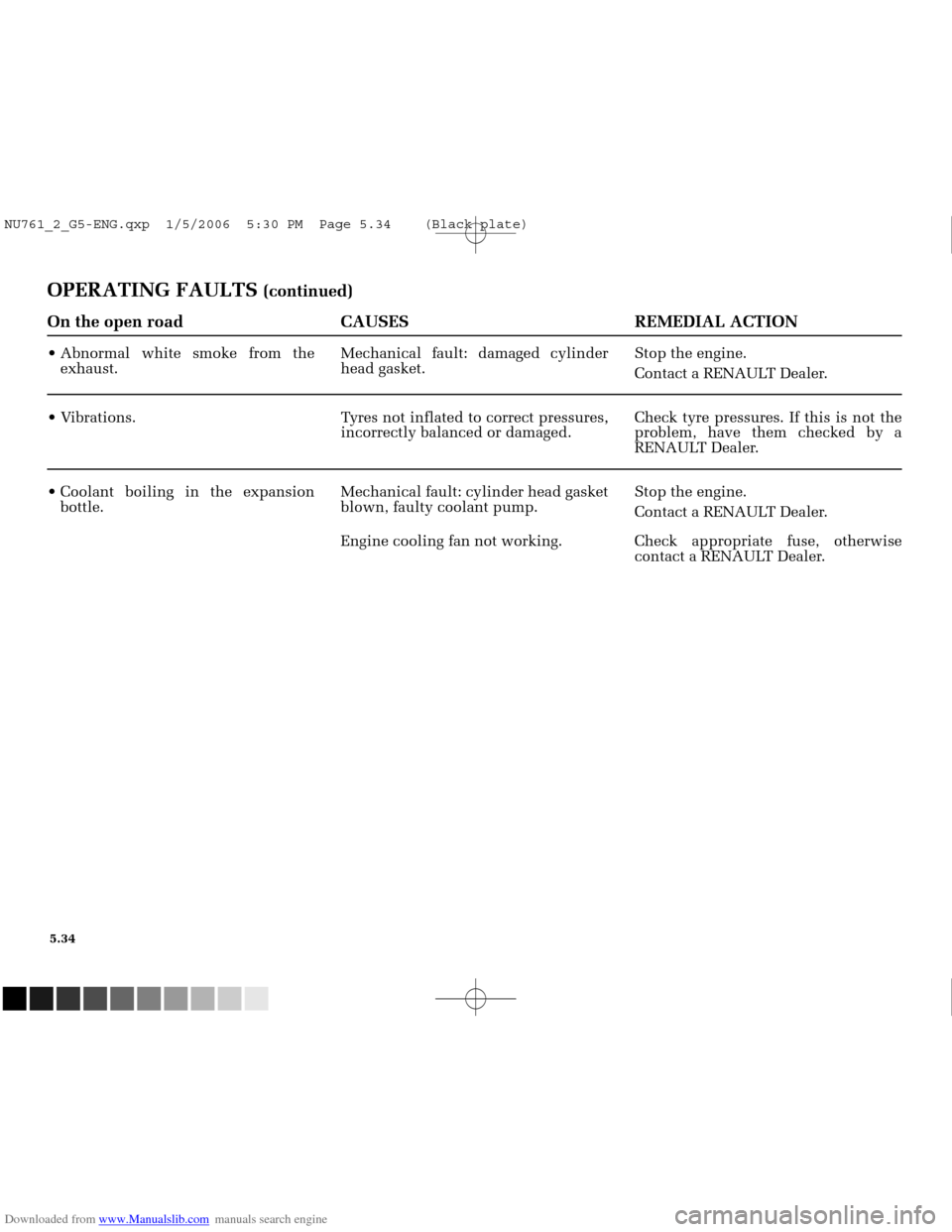
Downloaded from www.Manualslib.com manuals search engine
NU761_2_G5-FRA.qxd 4/11/05 11:10 Page 5.34
5.34
OPERATING FAULTS (continued)
On the open road CAUSES REMEDIAL ACTION
Abnormal white smoke from the exhaust. Mechanical fault: damaged cylinder
head gasket. Stop the engine.
Contact a RENAULT Dealer.
Vibrations. Tyres not inflated to correct pressures,
incorrectly balanced or damaged.Check tyre pressures. If this is not the
problem, have them checked by a
RENAULT Dealer.
Coolant boiling in the expansion
bottle. Mechanical fault: cylinder head gasket
blown, faulty coolant pump. Stop the engine.
Contact a RENAULT Dealer.
Engine cooling fan not working. Check appropriate fuse, otherwise contact a RENAULT Dealer.
NU761_2_G5-ENG.qxp 1/5/2006 5:30 PM Page 5.34 (Black plate)